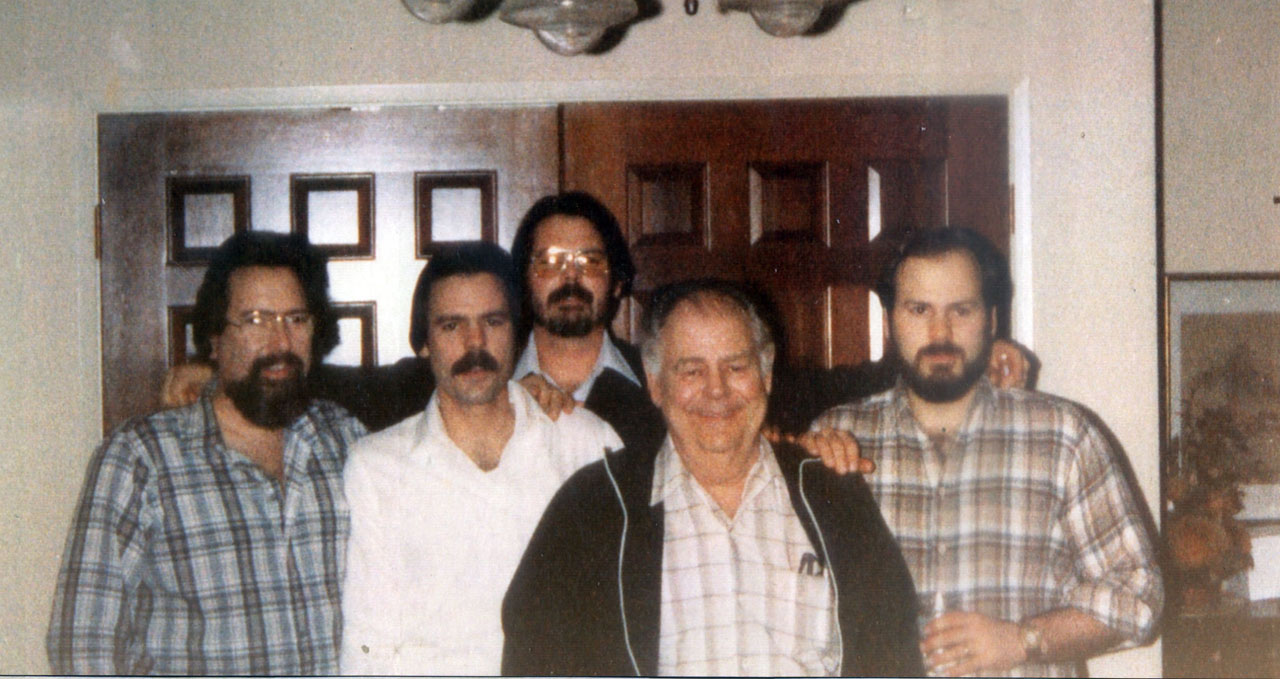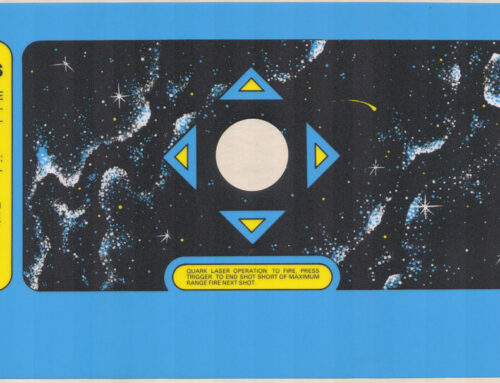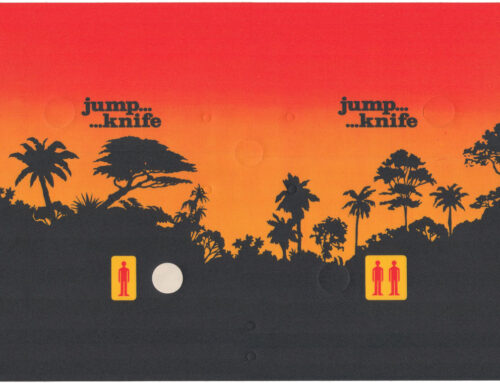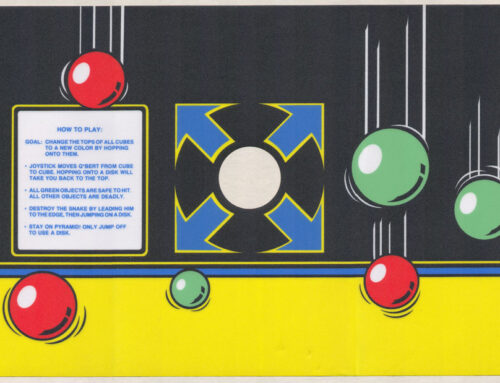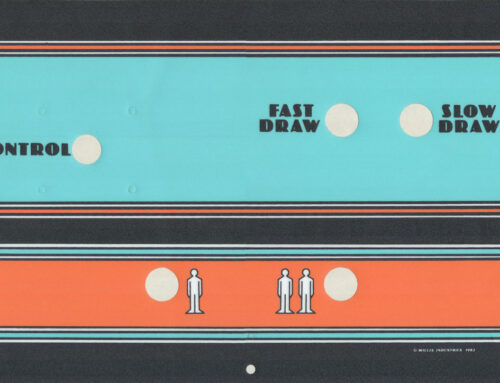Willis Family (L to R) Bob, Mark, Dave, and Steve with their Father in the late 1970’s or early 1980’s.
I have always been drawn to unusual arcade game artwork. Not just the beautiful work by manufacturers like Atari, Centuri or Universal, but the weird and ugly stuff operators slapped on cabinets to make them look new again. As a collector living in Chicago I was exposed to lots of crazy artwork through conversions, bootlegs, reproductions, you name it. I was fascinated by the weird things operators would do to their games and wondered where all this “bootleg” artwork was coming from. As I dug into the history I learned about Willis replacement overlays and how the name had become a term collectors used to refer to any bad bootleg overlay. It didn’t make sense to me. When I looked at a Willis overlay, you could tell it was far superior to some of the “bootleg” overlays you could easily find back then. I wanted to know more but there are very few sources of research data available, and almost nothing that focused on artwork production. After years of causal research I had about given up, when something amazing happened. A member of the Willis family reached out to me through this very website. A short time later I had the privilege of speaking with David Willis, former production supervisor for Willis Industries, and brother to Bob Willis, founder of the company.
My interview with David Willis occurred by phone on October 24, 2014. Almost ten years ago. Life, family, work all took priority and this post is long overdue. Without further delay, the following is my interview with David Willis. He was excited to talk with me and happy that someone had taken an interest in the work they had done for the arcade industry. He was so enthusiastic that he talked and kept on talking! Which is great because David had a lot to say and he reveals a number of interesting things about the process, the people and companies they worked for. It’s a long interview, 19 pages of transcript long, and I will need to break it up into multiple parts so its easy to digest. I hope you’ll follow along, I promise it is worth it!
Interview with David Willis – page 1
Phone rings.
David: This is Dave. May I help you?
Chris: Hi Dave. My name is Chris. I am calling because I had been speaking to your son.
David: Yes.
Chris: About your days back with Willis Industries.
David: Yeah.
Chris: I was wondering if you had time to answer some questions.
David: If I can, I will.
Chris: Okay. Sounds good!
David: Yeah.
Chris: So, can I ask you when did you get started with Willis?
David: It was R&N, and it was about 1972 or 1973, I think.
Chris: Okay. And was the company already established by your brother, or were you part of the startup process?
David: No. What it was was my brother, in high school, was a hand sign painter, and everybody in the neighborhood knew he was a sign painter. And one of the city councilmen wanted him – you know, like in a butcher shop where you have paper, they would paint on it for advertising their goods.
Chris: Yes, I understand.
David: Okay. Well, so anyway, the city councilmen wanted him to do like 500 signs to put all over the town. And what he did was, he hired a couple of his friends and they were painting them in our dad’s garage. And his friend said, “We can’t do it. It’s too many. We’re gonna have to silk screen ’em.” So, his friend and him got a silk screen and started silk screening ’em, and that was his introduction to silk screen printing. It was crude, but they had a quite good system and he got familiar with silk screening. Then, he got married to Nancy. And after he was married to Nancy, as a kid, he applied for a job as a silk screen printer at an electronics company, Varian, in California.
Chris: Mm-hm.
David: It’s a big commercial shop.
This first page is packed with a lot of information. I’m amazed that as a high school kid in the late 1960’s or very early 1970’s, Bob Willis was a hand sign painter making signs for the butcher shop. He was good enough that people around town knew about him, and it was this artistic skill which landed him the big political sign job. Eventually leading into screen printing in its most basic form. Dave Willis mentions his marriage to Nancy and calls him (Bob) a kid, so my guess is they got married shortly after high school. R&N Silkscreening was Robert & Nancy. You can see a piece of R&N artwork below, though it has the San Jose CA location which came later. Yes, that is Willis Asteroids side art, and it is cool.


Interview with David Willis – page 2
Chris: To actually do the silk screening on circuit boards, you mean?
David: Yeah. Well, I don’t know. It wasn’t actual circuit boards; just electronics, chassis and mainframes, where they put tubes through with electronics.
Chris: Got ya.
David: Circuit board-type. It was electronics, and his friend was Bob Morrow, who ran the shop; and Bob knew he didn’t know anything about silk screening other than a crude form. He knew the term, and he knew the application with a squeegee and a screen; but he didn’t have any application experience other than the signs. So, his friend, Bob, took him under his wing, and he double-printed for my brother until he got “up to speed.”
Chris: That was nice of Bob Morrow to help your brother like that.
David: Yeah, but then he left Varian to work for a man named Jerry Cennamo at Screentronics, which was in Redwood City. And it was an electronic silk screening company, similar to what he was doing at Varian, but he left for a 50-cent an hour raise.
Chris: Okay, so he was learning the business.
David: Then, what happened was he got to be friends with this customer, and the customer let him know that he was having 500 parts a week printed for $4.00 a part.
Chris: Okay, interesting.
David: And the customer said, “How much are you making out of the deal?” (meaning the screen printing work) And Bob told him his hourly wage, and he laughed and said, “Well, do you realize if I paid you $2.00 a part for the printing, if you could do it on your own, you can triple your wage and have a couple of days off a week?” So, Bob thought about it and started a garage operation with the customer, and soon-followed a few more customers; and he was making a lot of money for a guy just printing in his garage. He was making almost $2,000.00 to $3,000.00 a week. So, he, soon after that, opened up a small – well no, what he did – at that point, he was racing motorcycles. We’ve all had motorcycles in our family for many, many years, and he was racing all the time he was working for these other people too. And in racing, you have to have a number plate on your motorcycle.
Chris: Mm-hm.
David: Actually, there were three number plates on your bike; one on either side of the bike and then, one in the front. And he would hand paint the numbers, and he would make an additional charge if he did shading.
So Bob was working at Varian doing screen printing on electronic components or housings, doing the 9 to 5 thing. Varian – which still exists today, started with vacuum tube style electronic equipment, before moving into computers through an acquisition in 1967. Bob then left for a 50 cent raise which seems like nothing these days, but in 1970 minimum wage was $1.45. The opportunity to take on another garage job came up and he took the chance, making up to $3000 a week back then. If we assume Bob worked 5 days a week for at least 10 hours a day, that would still come out to about $60 an hour. Quite the pay increase for that time. I think a picture of Bob with his Red Corvette is appropriate.

Bob Willis with electrician at shop on Zarker Rd
Interview with David Willis – page 3
So, he had the number plate business in addition to R&N Silk Screening, and that was called “Buffalo Number Plate.” And eventually, he got a master set drawn up, and he put them on silk screens. And that was an actual business, ’cause they raced motorcycles all the way from little kid tracks up to nationals – those are the big tracks. They do the miles – San Jose Mile. You have Jim Wright, you know, and real expensive. You’re either sponsored by Harley, Honda, Kawasaki – you know, all those at the upper level number plates. So, there is a big market for that. So, he was selling number plates that were on fiberglass, and you get like a 4 x 8 sheet and cut it down to the right size and round the edges and then he would print the numbers and hand shade it so that they would have a shading, if you wanted it. So, what he did was, he had that business, and then he sold that business to his friend, who was a professional racer. And that guy printed number plates. And later, because of his experience in printing, he bought R&E Sign and Decal for a couple of hundred-thousand dollars, and he opened that up as his business.
Chris: And this was Robert that bought R&E Sign and Decal, or was it his friend?
David: Yeah. His friend, who was the motorcycle racer, bought the business “Buffalo Number Plate.”
Chris: Got ya.
David: He got acclimated in printing. He got comfortable, and an existing business came up for sale, R&E Sign and Decal, in Santa Clara.
Chris: Mm.
David: And he bought that and owned it and furthered his business in silk screening with R&E Sign and Decal; but he got his start from Bob by buying the number plate business.
Chris: Got ya.
David: And then, his friend, Bob Morrow, who worked at Varian, got married to a lady who owned a silk screening business. And for 30 years after he left Marian, they ran a business too. So, that guy that helped my brother at Varian get acclimated to screen printing was also an owner of a silk screen shop. So, it was little network of these people that graduated from humble beginnings to being pretty successful main-name people in the industry, in Santa Clara. They did like IBM – my brother did print IBM too. But anyway, let me get back to where I was on that with my brother. So, he sold that business, and then, he had his couple of accounts that he got from leaving his hand printing job at Screentronics. And so, he had so much work he had to go to work in a business. You know, it was too much for a residential area. It was a real legitimate concern, so he opened up R&N Silk Screening, and he rented a little shop. And it was probably, I would say, maybe 1000 square-feet or so. And that’s when I – sometime after he opened his shop, I came down and joined him. And that was when Pete Kauffman was the owner of Exidy.
Bob Willis was quite the entrepreneur, selling one business and then starting up another due to the amount of work he had. Dave Willis joined the company and he mentions Pete Kauffman of Exidy fame at this point in the interview. H.R. “Pete” Kauffman founded Exidy (Excellence in Dynamics) in Palo Alto CA in 1973, so the official business location for R&N must have opened around the same time. With the new shop in place things are about to get interesting, stay tuned! Next part coming soon.

